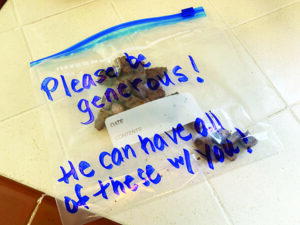More than a year into living under the cloud of a worldwide pandemic, we’re all still dealing with lifestyle changes to stay safe. For most people, this includes not being able to accompany pets into the vet’s office as practices continue curbside service. Some dogs (and some owners!) are handling this reality better than others.
While COVID statistics in many states are finally trending in a better direction, it’s impossible to know exactly what the future holds or when veterinary practices will begin allowing clients back inside. The following tips will help you make the most of a challenging situation.
* Ask yourself: Is the visit absolutely necessary? At the height of the pandemic, many practices were limiting non-essential procedures, including spay/neuter surgery. While we’d never recommend denying care, if you’re comfortable, consider a watch-and-wait approach for minor issues.
Similarly, take extra caution to avoid accidents that would require veterinary care.
* Pass notes. Write down the information you’d like the vet to know about your dog’s current situation. Be concise! In many practices, a veterinary assistant will come out to your car and ask you some initial questions about your dog and his issues, before taking your dog inside for the vet to examine. Send your notes in with your dog. Then, the vet can read the notes before her examination, and discuss them with you when she calls or comes out to talk to you.

* Up your treat game. We may not be able to go inside to make sure our dog doesn’t get stressed or frightened, but we can at least send in something to try to make him feel better: High-value treats! The last time my dog needed a blood draw prior to a medication refill, I filled a plastic bag with cooked morsels of meat. I wrote, “Please be generous!” on the baggie, and handed it to the assistant as he trotted my dog inside. It must have helped, because Saber came out happy and licking his lips!
* Ask questions. If you don’t ask, the answer is always no. It won’t hurt to ask if the vet would be comfortable examining your dog outside, or if you can walk your dog to the door before handing him off. Advocate for your dog, but understand sometimes the answer is “No” – and be respectful. Practices are trying to keep everyone safe. When staff calls out sick with COVID, it can devastate a practice – especially a smaller one.
* Consider a mobile vet. In the case of gut-wrenching end-of-life decisions, ask your vet if she can refer you to a mobile practitioner who can safely assist you and your dog at home. This event is already difficult emotionally, but not being present with your dog for euthanasia may be even more traumatic.
* Practice and be prepared. For some dogs, vet visits are stressful under the best circumstances. Training cooperative care skills at home can alleviate some of the anxiety during vet visits. Fenzi Dog Sports Academy (fenzidogsportsacademy.com) offers excellent online courses for cooperative canine care. (Also, see “Cooperative Care: Giving Your Dog Choice and Control” WDJ February 2021.) If your dog is extremely anxious and considered a bite risk, train him to happily wear a muzzle that you apply before sending him inside. (See “Mellow Muzzling,” page 4.)
It’s easy to become frustrated by COVID-era rules. Take a breath and practice patience and kindness – not just with your dog, but also in your interactions with your highly valued veterinary health care team.






